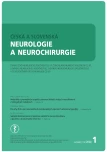Olfaction disorder after trans-nasal endoscopic surgery of pituitary adenoma
Authors:
J. Lubojacký 1,2
; M. Masárová 1,2; M. Plášek 1,2; T. Krejčí 3,4; Petr Matoušek 1,2
; R. Lipina 3,4; Pavel Komínek 1,2
Authors‘ workplace:
Klinika otorinolaryngologie, a chirurgie hlavy a krku FN Ostrava
1; Katedra kraniofaciálních oborů, LF OU, Ostrava
2; Neurochirurgická klinika FN Ostrava
3; Katedra klinických neurověd, LF OU, Ostrava
4
Published in:
Cesk Slov Neurol N 2022; 85(1): 33-37
Category:
Original Paper
doi:
https://doi.org/10.48095/cccsnn202233
Overview
Aim: Smell is often an underestimated sense; its loss leads to a decrease in quality of life with an increased susceptibility to depression. The aim of this work is to evaluate whether smell and nasal breathing deteriorate after trans-nasal endoscopic pituitary surgery. Patients and methods: In patients with pituitary adenoma indicated for endoscopic trans-nasal extirpation, smell (perfumed fixation test, olfactory questionnaire, Visual Analogue Scale), nasal breathing (Visual Analogue Scale) and postoperative nasal complications (synechia and septal perforation) using nasal endoscopy were evaluated preoperatively and four months postoperatively. Results: The study included 42 females and 40 males, with a mean age of 56 years. Anosmia was detected preoperatively in 11/ 82 (13.4%) patients. Postoperative olfactory deterioration occurred in 2/ 71 (2.8%) patients. Subjective deterioration of smell was observed in 9/ 82 (10.9%) patients and subjective deterioration of nasal breathing after surgery was observed in 3/ 82 (3.6%) patients. Postoperatively, 76/ 82 (92.7%) patients had no nasal complications. Synechia was observed in 6/ 82 (7.3%) patients, and septal perforation was not observed in any of the patients. Conclusion: This retrospective study showed a very low risk of olfactory disorders and impaired nasal breathing after trans-nasal pituitary adenoma surgery. Nasal complications were observed infrequently and did not aff ect nasal functions.
Keywords:
Pituitary adenoma – endoscopic trans-nasal approach – trans-sphenoidal approach – olfaction
Sources
1. Messerer M, Cossu G, George M et al. Endoscopic endonasal trans-sphenoidal approach: minimally invasive surgery for pituitary adenomas. J Vis Exp 2018; (131): 55896. doi: 10.3791/ 55896.
2. Regmi D, Thapa A, Kc B et al. Endoscopic endonasal transsphenoidal approach to pituitary adenoma: a multi-disciplinary approach. J Nepal Health Res Counc 2017; 15(2): 174–177. doi: 10.3126/ jnhrc.v15i2.18209.
3. Netuka D, Masopust V, Beneš V. Léčba adenomů hypofýzy. Cesk Slov Neurol N 2011; 74/ 107(3): 240–253.
4. Rochet M, El-Hage W, Richa S et al. Depression, olfaction, and quality of life: a mutual relationship. Brain Sci 2018; 8(5): 80. doi: 10.3390/ brainsci8050080.
5. Croy I, Nordin S, Hummel T. Olfactory disorders and quality of life-an updated review. Chem Senses 2014; 39(3): 185–194. doi: 10.1093/ chemse/ bjt072.
6. Schreiber A, Bertazzoni G, Ferrari M et al. Nasal morbidity and quality of life after endoscopic transsphenoidal surgery: a single-center prospective study. World Neurosurg 2019; 123: e557–e565. doi: 10.1016/ j. wneu.2018.11.212.
7. Rotenberg B, Tam S, Ryu WH et al. Microscopic versus endoscopic pituitary surgery: a systematic review. Laryngoscope 2010; 120(7): 1292–1297. doi: 10.1002/ lary.20949.
8. Soyka MB, Serra C, Regli L et al. Long-term olfactory outcome after nasoseptal fl ap reconstructions in midline skull base surgery. Am J Rhinol Allergy 2017; 31(5): 334–337. doi: 10.2500/ ajra.2017.31.4463.
9. Sergeant MJT, Davies MN, Dickins TE et al. The selfreported importance of olfaction during human mate choice. Sexualities, Evolution & Gender 2005; 7(3): 199 – 213. doi: 10.1080/ 14616660500173685.
10. Kassam AB, Prevedello DM, Carrau RL et al. Endoscopic endonasal skull base surgery: analysis of complications in the authors‘ initial 800 patients. J Neurosurg 2011; 114(6): 1544–1568. doi: 10.3171/ 2010.10.JNS09 406.
11. Wu V, Cusimano MD, Lee JM. Extent of surgery in endoscopic transsphenoidal skull base approaches and the eff ects on sinonasal morbidity. Am J Rhinol Allergy 2018; 32(1): 52–56. doi: 10.2500/ ajra.2018.32.4499.
12. Kim do H, Hong YK, Jeun SS et al. Anatomic Changes caused by endoscopic endonasal transsphenoidal surgery and their eff ects on nasal functions. Otolaryngol Head Neck Surg 2016; 154(6): 1132–1137. doi: 10.1177/ 0194599816630726.
13. Kim DH, Hong YK, Jeun SS et al. Intranasal Volume changes caused by the endoscopic endonasal transsphenoidal approach and their eff ects on nasal functions. PLoS One 2016; 11(3): e0151531. doi: 10.1371/ journal. pone.0151531.
14. Eccles R. Nasal airflow in health and disease. Acta Otolaryngol 2000; 120(5): 580–595. doi: 10.1080/ 000 164800750000388.
15. Gallagher MJ, Durnford AJ, Wahab SS et al. Patient-reported nasal morbidity following endoscopic endonasal skull base surgery. Br J Neurosurg 2014; 28(5): 622–625. doi: 10.3109/ 02688697.2014.887656.
16. Vodička J, Faitlová H, Chrobok V. Poruchy čichu a chuti. In: Vodička J, Dudová I, Matoušek P (eds.). Příčiny poruchy čichu. 1. vyd. Havlíčkův Brod: Tobiáš 2012 : 76–117.
17. Yan CH, Rathor A, Krook K et al. Eff ect of omega-3 supplementation in patients with smell dysfunction following endoscopic sellar and parasellar tumor resection: a multicenter prospective randomized controlled trial. Neurosurgery 2020; 87(2): E91–E98. doi: 10.1093/ neuros/ nyz559.
18. Sowerby LJ, Gross M, Broad R et al. Olfactory and sinonasal outcomes in endoscopic transsphenoidal skull-base surgery. Int Forum Allergy Rhinol 2013; 3(3): 217–220. doi: 10.1002/ alr.21103.
19. Croft CB. Clinical anatomy of the nose, nasal cavity and paranasal sinuses. Clin Otolaryngol Allied Sci 1991; 16(4): 430–430. doi: 10.1111/ j.1365-2273.1991.tb02084.x.
20. Netuka D, Masopust V, Fundová P et al. Olfactory results of endoscopic endonasal surgery for pituitary adenoma: a prospective study of 143 patients. World Neurosurg 2019; 129: e907–e914. doi: 10.1016/ j. wneu.2019.05.061.
21. Hart CK, Theodosopoulos PV, Zimmer LA. Olfactory changes after endoscopic pituitary tumor resection. Otolaryngol Head Neck Surg 2010; 142(1): 95–97. doi: 10.1016/ j.otohns.2009.09.032.
22. Chaaban MR, Chaudhry AL, Riley KO et al. Objective assessment of olfaction after transsphenoidal pituitary surgery. Am J Rhinol Allergy 2015; 29(5): 365–368. doi: 10.2500/ ajra.2015.29.4206.
Labels
Paediatric neurology Neurosurgery NeurologyArticle was published in
Czech and Slovak Neurology and Neurosurgery

2022 Issue 1
Most read in this issue
- Multiple tumefactive brain lesions as the first symptoms of demyelination
- Spontaneous intracranial hypotension
- Deep brain stimulation advances in neurological diseases
- Analytical and pre-analytical aspects of neurofilament light chain determination in biological fluids
